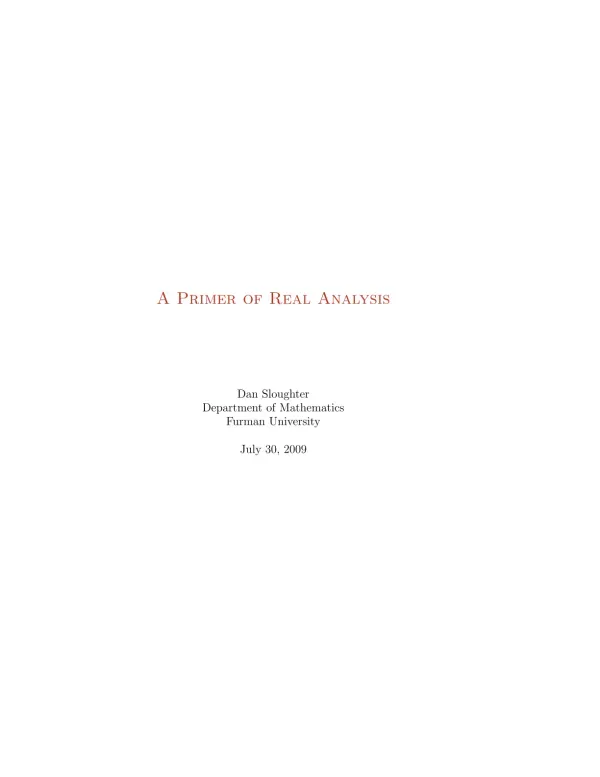
Fundamentals of Real Analysis: A Comprehensive Introduction
Document information
| Author | Dan Sloughter |
| School | Furman University |
| Major | Mathematics |
| Year of publication | 2009 |
| Place | Greenville |
| Document type | thesis |
| Language | English |
| Number of pages | 152 |
| Format | |
| Size | 2.54 MB |
- Real Analysis
- Mathematical Proof
- Calculus
Summary
I. Fundamentals
The Fundamentals of Real Analysis serve as the foundation for understanding more complex mathematical concepts. This section introduces essential concepts such as sets, relations, and functions. The text emphasizes the importance of mathematical maturity, which includes familiarity with basic algebraic properties and the ability to engage with mathematical proofs. The author asserts that a solid grasp of these fundamentals is crucial for further study in real analysis. The exploration of sets begins with the definition of integers, highlighting their unique properties and the operations that can be performed on them. The Fundamental Theorem of Arithmetic is introduced, stating that every integer can be expressed as a product of prime numbers, emphasizing the uniqueness of this factorization. This foundational knowledge is vital for students as they progress in their mathematical education.
1.1 Sets and Relations
In this subsection, the concept of sets is explored in depth. A set is defined as a collection of distinct objects, and the text provides various methods for constructing sets based on properties. The notation used to denote membership in a set is explained, along with the definitions of subsets, unions, intersections, and differences. The author illustrates these concepts with examples, reinforcing the idea that understanding sets is essential for grasping more advanced topics in analysis. The discussion of relations follows, where the author outlines how sets can be related to one another through various operations. This foundational knowledge is crucial for students as they encounter more complex mathematical structures in their studies.
II. Sequences and Series
The section on Sequences and Series delves into the behavior of ordered lists of numbers and their summation. A sequence is defined as a function whose domain is the set of natural numbers, and the text discusses various types of sequences, including arithmetic and geometric sequences. The concept of convergence is introduced, explaining how sequences can approach a limit. The author emphasizes the significance of understanding sequences as they form the basis for more complex mathematical analysis. The discussion extends to infinite series, where the author explains how to sum an infinite number of terms. The comparison tests for convergence are also covered, providing students with tools to analyze the behavior of series. This section is crucial for students as it lays the groundwork for understanding calculus and its applications.
2.1 Sequences
In this subsection, the author elaborates on the properties of sequences, including their limits and the concept of limit superior and limit inferior. The completeness of the real numbers is discussed, emphasizing that every bounded sequence has a limit. The author provides examples to illustrate these concepts, reinforcing the importance of sequences in real analysis. The section concludes with a discussion of subsequences, highlighting their role in understanding the behavior of sequences. This foundational knowledge is essential for students as they progress to more advanced topics in analysis.
III. Limits and Continuity
The exploration of Limits and Continuity is a pivotal aspect of real analysis. The author begins by defining limits and their significance in understanding the behavior of functions. The text discusses various types of limits, including limits of polynomials and rational functions. The concept of continuity is introduced, with a focus on the conditions under which a function is continuous at a point and over an interval. The Intermediate Value Theorem and the Extreme Value Theorem are presented, providing students with critical tools for analyzing functions. The author emphasizes the practical applications of these concepts in real-world scenarios, such as physics and engineering, where understanding the behavior of functions is essential.
3.1 Limits
In this subsection, the author delves deeper into the concept of limits, providing a rigorous definition and exploring various techniques for calculating limits. The text discusses the importance of limits in determining the behavior of functions as they approach specific points. The author also addresses common pitfalls and misconceptions related to limits, ensuring that students develop a solid understanding of this fundamental concept. The significance of limits extends beyond theoretical mathematics, as they are crucial in fields such as physics, where they help describe motion and change.
Document reference
- A Primer of Real Analysis (Dan Sloughter)
- Fundamental Theorem of Arithmetic (Unknown)
- Mean Value Theorem (Unknown)
- Taylor’s Theorem (Unknown)
- Intermediate Value Theorem (Unknown)
